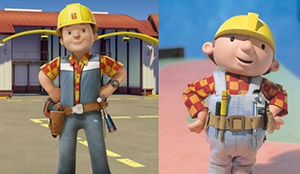
Bob the Builder is a well-known, stop-motion CBBC/PBS television show about Bob and his trusted friends who work on construction sites, making repairs, and doing renovations. Bob and his friends often encounter issues and his catch-phrase is “Can we fix it?” to which his characters respond, “Yes we can!”
Bob and his friends promote conflict resolution, teamwork, and cooperation. Children are often interactive with the show and it has received a terrific response. But what does Bob the Builder have to do with an article on mental health?
There is an Israel newspaper entitled “Yanshuf” (“Owl”), that is geared toward teaching Hebrew to students in the Diaspora. In a recent issue there was an article titled “Bob the Builder Goes on a Diet.” The piece discusses the recent “makeover” of the Bob the Builder character; he had once been short with an average build—as far as a cartoon character could be. He has a round face and wide smile and wears his trademark construction hat and overalls. And yet, Bob has been put on a diet. His character has been made taller, he is now thinner, has a new outfit, and distinct facial features. Apparently the title character was made over to “better suit viewers.”
Many television characters adapt, just as people adapt. However, the idea that a slimmer, stronger Bob the Builder would be better suited and appreciated by viewers—young viewers—reflects a trend in our society that may be alarming. It is highly doubtful that if asked, a 4-year-old child would overtly state that s/he preferred a “thinner Bob.” And yet, it was believed that a slimmer Bob would appeal to the children and be better received. Most children notice a character’s expression, mood, or attitude. Granted, children may take note of a character’s appearance or outfit, but this is not generally what guides a young child to be enticed by a television show.
For many children, socialization and learned values are transmitted through television; kids watch TV and learn about friendship, honesty, right and wrong. These lessons can be taught through subliminal messaging or by apparent discussion, dialogue, and actions of and between characters. What is this makeover teaching children? When youngsters watch “Bob the Builder” they learn about teamwork and overcoming challenges. This new Bob the Builder has made advancements with regard to technology and tools—he now has a computer. There is an association, then, between the new, cool, “flashy” technology and the new appearance of this character; namely that his success and his new appearance are synonymous.
One cannot state absolutely that the media causes disordered eating or eating disorders. Still, we must be mindful of the impact the media can have not only on children, but on society in general. Bob the Builder, a character for young children was revamped because his new appearance was thought to be more appealing. It is not that viewers were taught about healthy eating, or that Bob was “sick.” Rather, his change in build was a reflection, on some level, of our societal norms and preferences. Children often act as sponges; they learn about who they are based on the people with whom they interact and the activities of which they partake. It is essential to foster an environment that focuses on the value of individuals, on the lessons that one can learn rather than outward transformation.
When my mother reviewed this article with her 7th grade students, the girls were baffled. “That is so crazy,” one of them remarked, “I liked him just the way he was, there was no need to change him!” It is encouraging that these tweens were able to express their confusion. But it must also be noted that many children, teenagers, and adults do not take the time to process these changes. Instead they are faced with absorbing the messages that are fed to them. It understandable, then, why awareness and a dialogue—especially between parents and adolescents—is key.
“Everyone has something to contribute in life, it doesn’t matter how they look” reads the final line in the Yanshuf article. While Bob the Builder may simply be a cartoon character, we have the opportunity to learn from this article and from his “makeover.” We are able to learn about the societal messages being passed down and we are able to learn about how we can begin to speak back to these messages whether it be through awareness, articles, or a simple conversation about the values that go beyond what is skin-deep.
By Temimah Zucker










